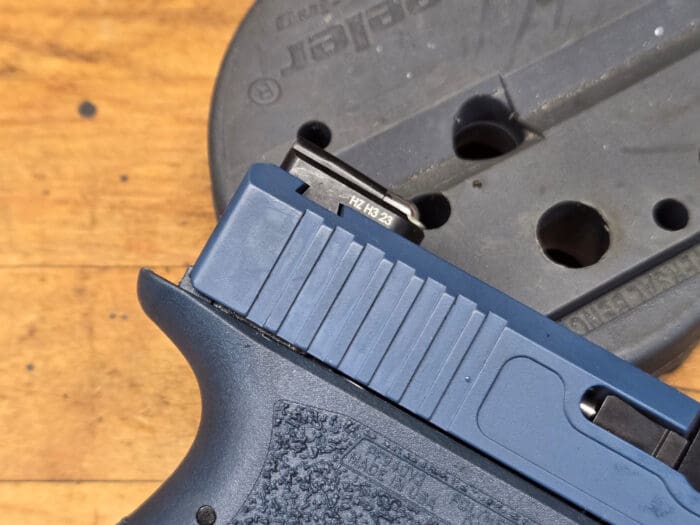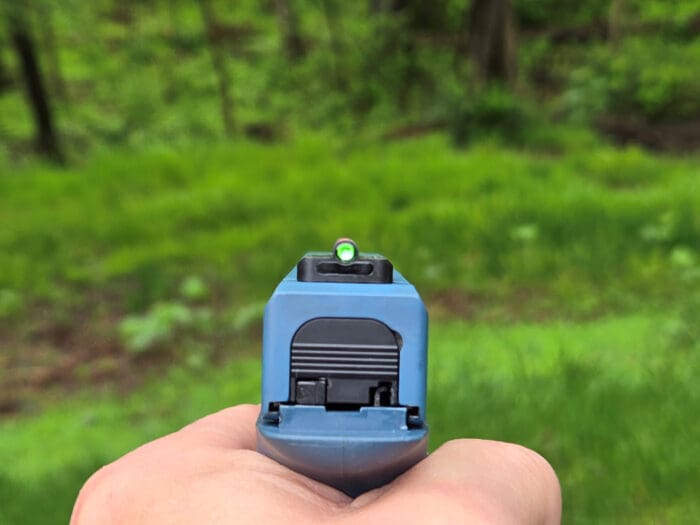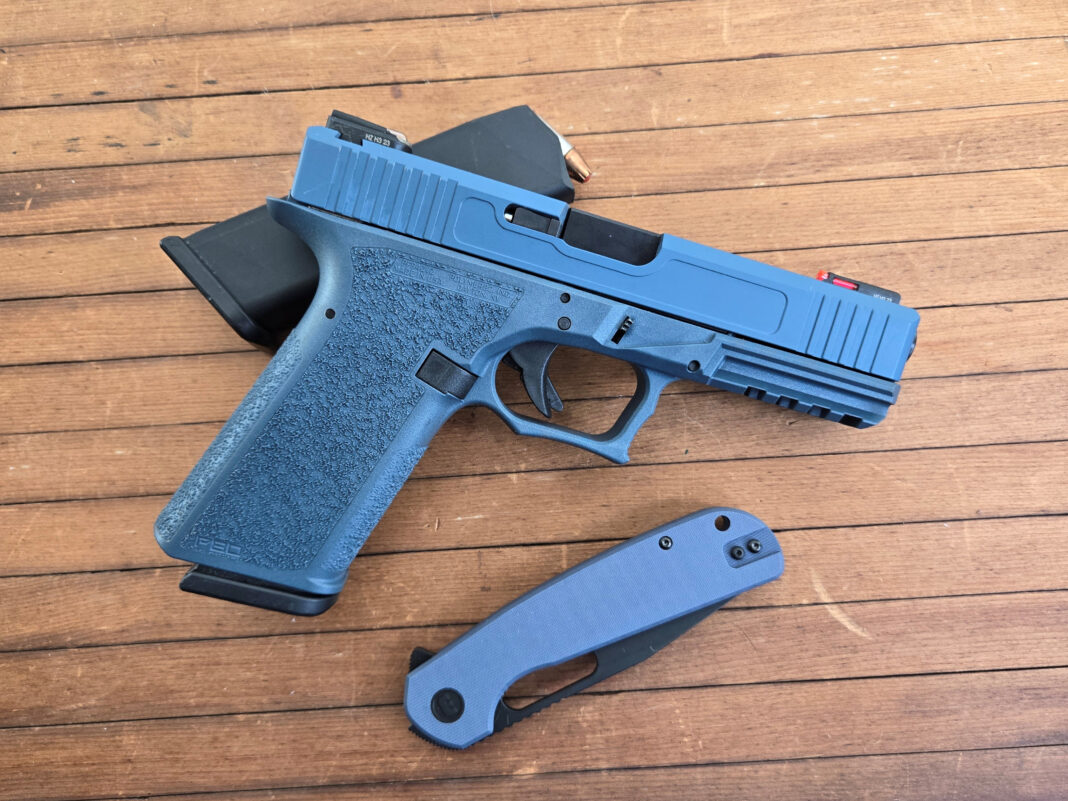Do you want the speed of a dot sight without the bulk, the batteries and the chance of mechanical failure? Well then the Hi Viz FastDot H3 Tritium and Fiber Optic system might be just what you’re looking for.
Industry Day at the Range takes place a day before the SHOT Show officially starts. It’s a live fire event for media and industry that takes place at the Boulder City Rifle Pistol Club, located just outside of Las Vegas. While it’s always nice to get some trigger time in, that time on the range also lets the gun and outdoor media experience some things first hand that might be hard to fully grasp just looking at pics on the web, or even handling the product in a booth at the show. For me the Hi Viz FastDot H3 was one of those systems.

The FastDot H3
The FastDot H3 is basically a set of iron sights available for Glocks , S&W M&Ps and Shield pistols and SIG P320s, but it works a lot differently than other iron sighting systems, including other systems that Hi Viz offers. Typically with any sighting system you line up the front sight with a groove, notch or some kind of aiming point on the rear sight. Sometimes there are dots or lines involved, and sometimes some tritium or fiber optic rods to enhance things but generally they work pretty similarly. The FastDot does not.

The front sight on the FastDot isn’t that much different than many modern front sights; it consists of a fiber optic front post and there’s the option of having a tritium insert as well. Good stuff, but nothing unusual. The rear sight is where things get interesting.

When you look at the rear sight you’d expect to see a notch of some sort, but you won’t find it. Instead you’ll see a single good sized dot protruding from the sight, mounted dead center. If you think it looks like it would obscure the front sight, you’d be right; it does. And that’s just what it’s intended to do.

The concept on the FastDot is that you stack the dots in line with each other. Not on top of each other, like the “dot the I” tyle sights but you literally want the front sight directly in front of the rear dot, to the point where you can’t see the front sight at all. If you catch any of the front dot creeping around the rear you aren’t lined up correctly. Think of it like an Eclipse.

The rear sight should get between the shooter’s eye and the front sight, obscuring it entirely. When it does you know the front and rear are in line and your sights are lined up on target. When you have a proper sight picture, all you see is one dot, just like if you were looking through a red dot sight.
So why would this be desirable compared to a traditional notch and front post, or 3-dot type setup? Speed is the main thing. Rather than your eye trying to findp the front post, and line it up in a notch in the rear or with a couple of other dots, all you’re looking for is a single dot. Similar to using a red-dot sight on a pistol.
I’ll be honest, it took me some getting used to, which is why I was glad I got to try it on the range, with someone there to explain it to me. It’s simple to use, but if you’re used to using traditional iron sights you need to “untrain” yourself. I initially spent too much time squinting down the sights trying to get things just so, rather than just bringing the sights up to eye level and letting things fall into place naturally.
Interestingly enough my buddy, who was with me at the range, adapted to the FastDot much easier than I did. It’s notable that he has a lot less trigger time behind a pistol than I do. He didn’t have the traditional sight picture as ingrained in his brain as me, and adapted very quickly to the system. He was getting hits on steel much quicker, and more accurately, than me. He had it down within the first magazine out of the gun. It took me a couple mags and some coaching, but it’s one of those things that once you “see” it, it’s an “Aha” moment, and then you have it.
I still think it’s something that needs regular practice, just like using a red dot. You practice your draw, bring the gun on target and acquire your sight picture. This can easily be done at home with dry fire practice, or even just drawing and bringing the pistol up to eye level.

Installation
I had a chance to try out a set of FastDot’s at home after the show. They come in a basic clam shell package with some simple instructions. You need a Glock front sight tool which HiViz sells if you don’t have one, and a way to put the rear sight on. I have sight pusher that I used, but I’ve also tapped rear sights in with brass punches before. I even did some adjustments with a punch once I had the rear sir sight on place after checking it. Of course you can always take them to a gunsmith if you don’t have the tools yourself, or bribe your buddy who does with some pizza or a 6 pack.

I will add a note on fit. The front and rear sight bases on the FastDot system are somewhat long. If you have a pistol with an optics cut the rear sight is going to overlap the cut cover plate. If you’re using the FastDot sight anyway, you probably aren’t planning on running an optic so it shouldn’t matter, but it’s worth noting. There is a version for the Glock MOS pistols though that places the rear sight further back to accommodate this. So far that’s only for the Glock though.
Similarly if you have a slide with a port or lightening cut behind the front sight, like my aftermarket 17L slide, the front sight base may hang over that gap. I ended up mounting my sights on a relatively factory profile aftermarket slide on a Poly80 build that I did a couple years ago. It was one of the few slides I had without an optics plate. It’s a 17 sized gun though so was a good test platform for the FastDot anyway.
Once installed I had a chance to work with the FastDot’s around the house with practice presentation and dry firing, as well as on a couple range trips.

Follow On Thoughts
Do I think the FastDot sights are as precise as a good set of target irons? I do not, and I don’t think that’s a fair comparison. You aren’t going to use these for slow, precise target shooting. But as a combat sight, they excel, if you put a little bit of time into them. It’s different set up, but if you can get past that they fast, and work well.
If we go back to my opening comment about wanting a red dot, without the disadvantages, there are a number of things to consider. You get the easy to use “drop the dot on target and fire” benefit of a red dot, but without the bulk, without needing a special mount, and all while being able to use a regular holster. If you’re upgrading a gun you carry now, you don’t have to buy new holsters for it like you would in many cases if you go to a red dot. You also don’t need to get your slide milled if it isn’t optics ready either. The other benefit is the cost of the sight itself. MSRP for the tritium fiber optic units is $179.00. That’s on par with other good tritium sight sets on the market, but considerably less than a duty rated red dot sight. And you never have to buy batteries for it.

The HiViz FastDot H3 is a solid system all the way around, if you’re willing to spend some training time with it, just like any other new platform. I think it’s actually a great system for newer shooters since lining up the dots seems to be easier to explain, and actually do, then explaining and mastering a proper notch and post sight picture. My sample size is small, but when demonstrating it to a few novice shooters they seemed to grasp it and get on target faster with the FastDot than the factory Glock sights. They don’t have anything to unlearn and the learning curve for them is easy. Older, curmudgeonly guys like me have to work past how we “know” things work to realize that there are still innovations in how we shoot, and that not all of them have to be expensive or complicated. FastDot sights are definitely one of those.
HiViz FastDot H3 Specs:
- Low Profile sight set
- Fits: All Glock pistols in 9mm, 40 S&W, and .357 Sig.
- Sight visibility in all light conditions
- Ultra bright encapsulated Tritium
- All steel construction
- Fits standard holsters
- Patented technology
- MSRP $175







Okay, I’ll be the first one here… ” Wait, you have a BLUE apparently functional pistol ??
What, was less-lethal orange sold out? ”
l
Wow that’s pretty neat.
I had a shotgunm with two beads on the rib.
Can I get a blue – gun -?
I’d like one with an orange piece of plastic on the end of the barrel though.
Ah shucks, I thought gun might be blue. Used to be.
That’s pretty neat. I like outside the box thinking, especially in regards to things that haven’t changed in umpteen years.
Why is your pistol blue?!? “Blue” guns are a safety tool that means it’s NOT a live fire capable gun for training purposes. For sh!ts sake stop that.
On second thought, @TTAG, like my recent experience at “Gun For Hire” in NJ when a guy in the shop pointed a pistol at me and the sales guy in an RSO shirt said nothing and gave me a dirty look when I spoke up… I’m not coming back, this is too stupid.
Having gunms pointed at you gets you used to a visit from the ATF.
That way you won’t be so nervous when they kill you , dead , dead, dead.
Right after they just killed your dog dead, dead, dead.
These people freaking out over a over a blue gun as if check double check and accountability don’t exist. If you can’t tell a P80 custom build apart from a blue Glock saftey pistol then I would not want to be around you with firearms and you probably shouldn’t have one to begin with. Blue is fine, your Funds mentality is not.
“If you can’t tell a P80 custom build apart from a blue Glock safety pistol then I would not want to be around you with firearms and you probably shouldn’t have one to begin with. Blue is fine, your Funds mentality is not.”
Pretty sure I don’t want to be around you if you think muzzling anyone with an authentic looking gun is meh
Silly me I never seen colorful real guns B4.
P.S. Got me an orange tip on my 1911 so you safe.
Did you try aiming with both eyes open? How did that work?
Good question! Would like to know.
Pretty sure using your strong eye you would be good to go. Weak eye… look out innocent bystanders!
Yep, that was my first reaction. Second thought was that the have a good process to avoid misalignment left, right, and high; what about low?
Maybe they should make the front sight large enough to get a hallow effect so you know you are lined up. As far as low I think you can only go so thin on the mount before you get in to making it too fragile to be useful.
Rear sight focused? A lot of good people are going get shot.
Then we’ll just chalk it up as “collateral losses” like the government agencies do – as long as at least SOME bad people also get shot it’s all good.
… oh, and by “bad people”, I mean anyone that THEY decide is bad.
Iron sights are for the gun Amish.
The future is now old people.
The scope looks nice. But I’ve have a 1-6×24 LPVO scope. And this is the details of my scope.
https://www.cvlife.com/products/cvlife-1-6×24-lpvo-scope-with-cantilever-mount
Do they have the same function? If don’t, I will buy another scope.